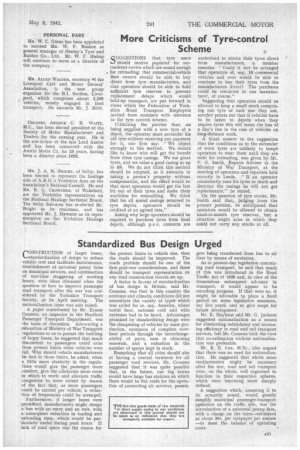Standardized Bus Design Urged
Page 23

If you've noticed an error in this article please click here to report it so we can fix it.
CONSTRUCTION of larger busn, standardization of design to reduce vehicle cost and facilitate maintenance, establishment of universal penny fares on municipal services, and continuation of war-time staggering of working hours, were ideas discussed when the question of how to improve passenger road transport after the war was considered by the Yorkshire Transport
Society, at its April meeting. The nationalization issue was also raised.
A paper contributed by Mr. Ernest Couzens, an inspector in the Bradford Passenger Transport Department, was the basis of discussion. Advocating a relaxation of Ministry of War Transport regulations so as to permit the building of -larger buses, he suggested that much discomfort to passengers could arise from present limits when vehicles were full. Why should vehicle manufacturers be tied to those limits, he asked, when a little more elasticity in the regulations would give the 'passenger more comfort, give the cOnductor more room in which to work; and alleviate traffic congestion to some extent by reason of the fact that, as more passengers could be carried per vehicle, a reduction of frequencies could be arranged.
Furthermore, if longer buses were permitted, manufacturers might design a bus with an entry and an exit, with a consequent reduction in loading and unloading time, which would be par-ticularly useful during peak hours. If lack of road space was the reason for
the present limits to vehicle size, then the roads should be improved. The roads problem should be one of the first post-war considerations, and there should be transport representation on any road construction boards set up.
A factor in favour of standardization of bus design in Britain, said Mr. Couzens, was that in this country the contours and climatic conditions did not necessitate the variety of types which was called for in, say, America, where torrid heat, extreme cold and wide extremes had to be faced. Advantages promised by standardizing design were the cheapening of vehicles by mass production, extension of complete overhaul periods through the interchangeability of parts, ease in obtaining renewals, and a reduction in the number of spares kept in stock. Remarking ttat all cities should aim at having a central terminus for all passenger road services, Mr. Couzens suggested that it was quite possible that, in the future, our big towns would have large bus stations on which there would be flat roofs for the operation of connecting air services, passen gers being transferred from bus to air liner by means of escalators.
As to present-day legislation concerning road transport, he said that much of this was introduced in the Road Traffic Act of 1930 and, in view of the tremendous subsequent advance in transport, it would appear to be retarding progress. If that were so, it might be advisable to place a fixed period on some legislative measures, say five yearS, and so give scope for future development.
Mr. E. Hayhirst and Mr. G. Jackson suggested nationalization as a means for eliminating redundancy and increasing efficiency in road and rail transport services, but Mr. Couzens took the view that co-ordination without nationalization was preferable.
Mr. R. E. Cox, M.Sc., also argued that there was no need for nationalization. He suggested that whilst some readjustments might be necessary after the war, road and rail transport were, on the whole, well organized to function in their respective spheres, which • were becoming more sharply defined.
A suggestion which, assuming it to be actuarily sound, would greatly simplify municipal passenger-transport operation on the traffic side, was the introduction of a universal penny fare, with a charge, on the rates—estimated at about 30s, per ratepayer per annum —to Meet the balance of operating costs.




















































